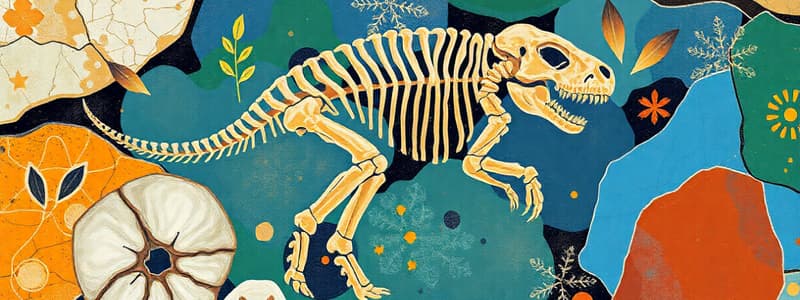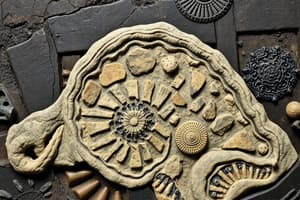Podcast
Questions and Answers
Which of the following are types of fossils?
Which of the following are types of fossils?
- Mold Fossil
- Trace Fossil
- Amber Fossil
- All of the above (correct)
What are fossils?
What are fossils?
Remains of ancient species or evidence of their remains that have been preserved.
Trace fossils are the actual remains of an organism.
Trace fossils are the actual remains of an organism.
False (B)
What is a mold fossil?
What is a mold fossil?
What process turns organic material into fossils?
What process turns organic material into fossils?
What is an amber fossil?
What is an amber fossil?
How are petrified fossils formed?
How are petrified fossils formed?
What is geothermal energy derived from?
What is geothermal energy derived from?
What are fossil casts?
What are fossil casts?
What characterizes a carbon film fossil?
What characterizes a carbon film fossil?
Which fossil type is formed from imprints left by organisms during daily activities?
Which fossil type is formed from imprints left by organisms during daily activities?
What process primarily leads to the formation of fossil fuels?
What process primarily leads to the formation of fossil fuels?
How do amber fossils typically preserve organisms?
How do amber fossils typically preserve organisms?
Which statement is true about fossilization?
Which statement is true about fossilization?
What type of fossil would you find that provides insight into an organism's behavior?
What type of fossil would you find that provides insight into an organism's behavior?
Which type of fossil is created when organic materials change into combustible geological deposits?
Which type of fossil is created when organic materials change into combustible geological deposits?
What do fossils primarily consist of?
What do fossils primarily consist of?
What is the primary process through which secondary pollutants are formed in the atmosphere?
What is the primary process through which secondary pollutants are formed in the atmosphere?
Which type of smog is primarily associated with internal combustion engines in urban centers?
Which type of smog is primarily associated with internal combustion engines in urban centers?
Which agent is NOT categorized as an agent of erosion?
Which agent is NOT categorized as an agent of erosion?
What is the primary consequence of sulfur dioxide smog on vegetation?
What is the primary consequence of sulfur dioxide smog on vegetation?
What role does the heat exchanger play in geothermal energy plants?
What role does the heat exchanger play in geothermal energy plants?
Which of the following describes the process of weathering?
Which of the following describes the process of weathering?
What type of pollutants are generated from smelting plants that treat sulfide ores?
What type of pollutants are generated from smelting plants that treat sulfide ores?
What are considered natural agents of weathering?
What are considered natural agents of weathering?
What is a characteristic of mold fossils?
What is a characteristic of mold fossils?
What differentiates a fossil cast from a mold fossil?
What differentiates a fossil cast from a mold fossil?
Which process transforms organic material into minerals in petrified fossils?
Which process transforms organic material into minerals in petrified fossils?
What is one major factor that leads to the formation of fossils?
What is one major factor that leads to the formation of fossils?
What role do sediments play in the fossilization process?
What role do sediments play in the fossilization process?
What happens to the fossil at the surface due to weathering and erosion?
What happens to the fossil at the surface due to weathering and erosion?
Which of the following best describes geothermal energy?
Which of the following best describes geothermal energy?
In dry steam power plants, how are the water and working fluid managed?
In dry steam power plants, how are the water and working fluid managed?
What is the major type of stress at divergent plate boundaries?
What is the major type of stress at divergent plate boundaries?
What process occurs when rain is slightly acidic and interacts with granite rocks?
What process occurs when rain is slightly acidic and interacts with granite rocks?
What effect does compression have on rocks at convergent plate boundaries?
What effect does compression have on rocks at convergent plate boundaries?
How does confining stress affect deeply buried rock?
How does confining stress affect deeply buried rock?
Which of the following best describes hydrolysis?
Which of the following best describes hydrolysis?
What role does carbonation play in geological processes?
What role does carbonation play in geological processes?
What occurs when rocks are under tension at divergent plate boundaries?
What occurs when rocks are under tension at divergent plate boundaries?
What is the result of confining stress on a deeply buried rock?
What is the result of confining stress on a deeply buried rock?
What type of stress occurs when forces slide past each other in opposite directions?
What type of stress occurs when forces slide past each other in opposite directions?
Which process involves minerals or rocks dissolving in water?
Which process involves minerals or rocks dissolving in water?
In which type of fold are the youngest rocks found at the center?
In which type of fold are the youngest rocks found at the center?
What is the main product of the oxidation of iron in the presence of water?
What is the main product of the oxidation of iron in the presence of water?
Which type of fold is characterized by an arch-like structure with rocks dipping away from the center?
Which type of fold is characterized by an arch-like structure with rocks dipping away from the center?
What is the result of compressional forces causing a fold to bend downward?
What is the result of compressional forces causing a fold to bend downward?
What type of valley features a distinct escarpment on each side?
What type of valley features a distinct escarpment on each side?
What happens to rock when stress is applied?
What happens to rock when stress is applied?
Flashcards are hidden until you start studying
Study Notes
Fossils
- Are the remains of ancient species
- Are evidence of past life
- Formed from sedimentary rocks
- Are usually formed from the hard parts of organisms (e.g. bones, shells, tree trunks)
Types of Fossils
- Mold Fossil: A hollow imprint of a dead organism that forms when sediments fill the space left by the organism after decomposition.
- Fossil Cast: A three-dimensional copy of the organism formed by sediment filling a mold fossil.
- Petrified Fossil: The remains of an organism that have been turned into a mineral, rock, or stone through the process of petrification.
- Carbon Film: A fossil that preserves an organism's outline as a thin layer of carbon on the surface of a rock.
- Trace Fossil: Preserved evidence of an organism's activity, such as footprints, burrows, or trails.
- Amber Fossil: An insect preserved in amber, a hardened fossilized resin from ancient trees.
Fossil Formation
- An organism dies and its soft parts decompose or are eaten by animals.
- The remains are covered by sediments.
- The sediments solidify into rock.
- The remains decompose further leaving holes in the sediment.
- These holes are filled by minerals.
- The result is a copy of the organism made out of minerals.
- The fossil is eventually exposed by weathering and erosion.
Geothermal Energy
- Geothermal comes from the Greek words gaea (earth) and thermos (heat)
- It covers all techniques used to recover heat that is naturally present in the Earth's subsurface.
- Often found in aquifers, which are rock reservoirs containing groundwater.
Dry Steam Power Plants
- ... (continued)
Studying That Suits You
Use AI to generate personalized quizzes and flashcards to suit your learning preferences.




